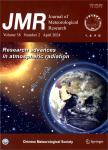A Convection-Allowing Ensemble Forecast Based on the Breeding Growth Mode and Associated Optimization of Precipitation Forecast
A Convection-Allowing Ensemble Forecast Based on the Breeding Growth Mode and Associated Optimization of Precipitation Forecast作者机构:college of meteorology and oceanographypla university of science and technologyNanjing 211101 nanjing joint center of atmospheric researchNanjing 210009 pla troop 96219Kunming 650200 pla troop 96319Puning 515347
出 版 物:《Journal of Meteorological Research》 (气象学报(英文版))
年 卷 期:2017年第31卷第5期
页 面:955-964页
核心收录:
学科分类:07[理学] 070601[理学-气象学] 0706[理学-大气科学]
基 金:Supported by the Natural Science Foundation of Nanjing Joint Center of Atmospheric Research(NJCAR2016MS02) National Natural Science Foundation of China(41205073,41275012,and 41275099)
主 题:convection-allowing ensemble forecast breeding growth mode (BGM) precipitation optimization prob-ability matched mean (PMM) neighborhood ensemble probability (NEP) Fractions Skill Score (FSS)
摘 要:A convection-allowing ensemble forecast experiment on a squall line was conducted based on the breeding growth mode (BGM). Meanwhile, the probability matched mean (PMM) and neighborhood ensemble probability (NEP) methods were used to optimize the associated precipitation forecast. The ensemble forecast predicted the precipita- tion tendency accurately, which was closer to the observation than in the control forecast. For heavy rainfall, the pre- cipitation center produced by the ensemble forecast was also better. The Fractions Skill Score (FSS) results indicated that the ensemble mean was skillful in light rainfall, while the PMM produced better probability distribution of pre- cipitation for heavy rainfall. Preliminary results demonstrated that convection-allowing ensemble forecast could im- prove precipitation forecast skill through providing valuable probability forecasts. It is necessary to employ new methods, such as the PMM and NEP, to generate precipitation probability forecasts. Nonetheless, the lack of spread and the overprediction of precipitation by the ensemble members are still problems that need to be solved.



